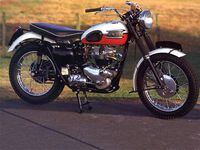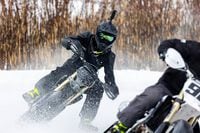The scrambler is a British motorcycle shaped by an American phenomenon. From the 1951 Catalina Grand Prix to the Pasadena Motorcycle Club's Greenhorn Enduro, four-stroke singles from AJS, Matchless and BSA ruled the California desert 50 years ago. Courses were mostly flat in those days, with plenty of long, straight high-speed stretches. But after hundreds of riders carved up the desert, it was tough to maneuver without crashing or getting stuck. Running out front required a balance of speed, handling and horsepower, and 500cc singles delivered just that.
Then Bud Ekins and the 650cc Triumph TR6 changed everything. As the fastest rider in the deserts of Southern California at the time, Ekins took an immediate liking to the 40-cubic-inch twin's potent combination of horsepower, handling and reliability. TR6-mounted Ekins, Bill Postel and Roger White won three consecutive Big Bear Runs from 1956 to 1958. But it was Ekins' fourth-straight win for Triumph in 1959 that was most noteworthy.
Pulling ahead of 852 other riders, Ekins grabbed an early lead on the first of the two 50-mile loops. He lost nine minutes and the race lead at the end of the second replacing a dented front rim and flat tire. No worries-not when you can turn up the TR6 wick high enough to take back the lead. Ekins ended the 153-mile race 22 minutes ahead of Jim Johnson on a Triumph 500 in a race where only 200 riders finished.
Ekins' success on the TR6 showed the way for others well into the 1960s. He would later gain fame as the man who actually jumped that barbed-wire fence for his friend Steve McQueen in The Great Escape. In the years that followed, Bud's riding and mechanical skills made him indispensable in Hollywood. Winning four gold medals in the International Six-Day Trials, Ekins had few peers as a racer. His '59 Big Bear win proved that.











/cloudfront-us-east-1.images.arcpublishing.com/octane/GTCXACQGJ5HAPDTGWUQKDEH44E.jpg)
/cloudfront-us-east-1.images.arcpublishing.com/octane/S35YGSEMEZB4BLTDJTSZPF4GLA.jpg)
/cloudfront-us-east-1.images.arcpublishing.com/octane/5UOT6HPX2JFMRJAX6EH45AR4MQ.jpg)
/cloudfront-us-east-1.images.arcpublishing.com/octane/OKWOJWAKP5EP3OACCRRWPCIX2Q.jpg)
/cloudfront-us-east-1.images.arcpublishing.com/octane/2WF3SCE3NFBQXLDNJM7KMXA45E.jpg)
/cloudfront-us-east-1.images.arcpublishing.com/octane/G4MG6OUCJNBSHIS2MVVOTPX65E.jpg)
/cloudfront-us-east-1.images.arcpublishing.com/octane/IIGGWFOTOJGB7DB6DGBXCCMTDY.jpg)
/cloudfront-us-east-1.images.arcpublishing.com/octane/QSTCM6AVEZA5JJBUXNIQ3DSOF4.jpg)
/cloudfront-us-east-1.images.arcpublishing.com/octane/U4I7G625B5DMLF2DVIJDFZVV6M.jpg)
/cloudfront-us-east-1.images.arcpublishing.com/octane/B6XD6LS6IVCQPIU6HXDJSM3FHY.jpg)
/cloudfront-us-east-1.images.arcpublishing.com/octane/ICL63FEDDRDTTMINYICCEYGMDA.jpg)
/cloudfront-us-east-1.images.arcpublishing.com/octane/FCGZHQXRBZFLBAPC5SDIQLVF4I.jpg)
/cloudfront-us-east-1.images.arcpublishing.com/octane/WNOB6LDOIFFHJKPSVIWDYUGOPM.jpg)

/cloudfront-us-east-1.images.arcpublishing.com/octane/X33NU3E525ECRHXLNUJN2FTRKI.jpg)
/cloudfront-us-east-1.images.arcpublishing.com/octane/6KKT5NNL2JAVBOXMZYS5ZO76YA.jpg)
/cloudfront-us-east-1.images.arcpublishing.com/octane/J5RKG5O455GMPGQRF2OG6LRT7A.jpg)
/cloudfront-us-east-1.images.arcpublishing.com/octane/GX2CIZKQVRH2TATDM26KFG2DAE.jpg)
/cloudfront-us-east-1.images.arcpublishing.com/octane/ZWIDYSAKQZHD5BHREMQILXJCGM.jpg)
/cloudfront-us-east-1.images.arcpublishing.com/octane/CYUHJZCTSJCH3MRAQEIKXK7SCQ.jpg)
/cloudfront-us-east-1.images.arcpublishing.com/octane/LKOFINY56FCXJCANJ5M7ZDQUBY.jpg)
/cloudfront-us-east-1.images.arcpublishing.com/octane/4NBPDACMWJH63JQYJVK3QRBDZI.jpg)
/cloudfront-us-east-1.images.arcpublishing.com/octane/KKHQHRR3FJGX7H2IPU6RALMWG4.jpg)
